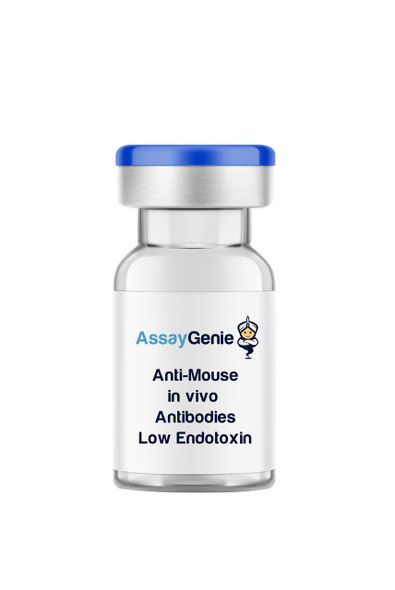Anti-Mouse CD318 In Vivo Antibody - Low Endotoxin
- SKU:
- IVMB0138
- Product Type:
- In Vivo Monoclonal Antibody
- Clone:
- 9A2
- Protein:
- CD318
- Isotype:
- Mouse IgG2b kappa
- Reactivity:
- Human
- Reactivity:
- Mouse
- Synonyms:
- CDCP1
- Synonyms:
- CD318
- Synonyms:
- TRASK
- Synonyms:
- SIMA135
- Endotoxin Level:
- Low Endotoxin
- Host Species:
- Mouse
- Applications:
- FC
Description
| Product Name: | Anti-Mouse CD318 In Vivo Antibody - Low Endotoxin |
| Product Code: | IVMB0138 |
| Size: | 1mg, 5mg |
| Clone: | 9A2 |
| Protein: | CD318 |
| Product Type: | Monoclonal Antibody |
| Synonyms: | CDCP1, CD318, TRASK, SIMA135 |
| Isotype: | Mouse IgG2b κ |
| Reactivity: | Human/Mouse |
| Immunogen: | His-tagged recombinant fragment from the internal region of human CUB domain-containing protein 1 |
| Applications: | FC |
| Formulation: | This monoclonal antibody is aseptically packaged and formulated in 0.01 M phosphate buffered saline (150 mM NaCl) PBS pH 7.2 - 7.4 with no carrier protein, potassium, calcium or preservatives added. |
| Endotoxin Level: | < 1.0 EU/mg as determined by the LAL method |
| Purity: | ≥95% monomer by analytical SEC >95% by SDS Page |
| Preparation: | Functional grade preclinical antibodies are manufactured in an animal free facility using only In vitro protein free cell culture techniques and are purified by a multi-step process including the use of protein A or G to assure extremely low levels of endotoxins, leachable protein A or aggregates. |
| Storage and Handling: | Functional grade preclinical antibodies may be stored sterile as received at 2-8°C for up to one month. For longer term storage, aseptically aliquot in working volumes without diluting and store at -80°C. Avoid Repeated Freeze Thaw Cycles. |
| Applications: | FC |
| Recommended Usage: | FC The suggested concentration for this 9A2 antibody for staining cells in flow cytometry is 1 µg per 106 in a volume of 100 µl. Titration of the reagent is recommended for optimal performance for each application. Each investigator should determine their own optimal working dilution for specific applications. See directions on lot specific datasheets, as information may periodically change. |
| Reactivity: | Human/Mouse |
| Host Species: | Mouse |
| Specificity: | Clone 9A2 recognizes an epitope within the extracellular domain of human/mouse CDCP1. |
| Antigen Distribution: | CDCP1 is widely expressed in the esophagus, skin, colon, duodenum, stomach and other tissues. |
| Immunogen: | His-tagged recombinant fragment from the internal region of human CUB domain-containing protein 1 |
| Concentration: | ≥ 5.0 mg/ml |
| Endotoxin Level: | < 1.0 EU/mg as determined by the LAL method |
| Purity: | ≥95% monomer by analytical SEC >95% by SDS Page |
| Formulation: | This monoclonal antibody is aseptically packaged and formulated in 0.01 M phosphate buffered saline (150 mM NaCl) PBS pH 7.2 - 7.4 with no carrier protein, potassium, calcium or preservatives added. |
| Preparation: | Functional grade preclinical antibodies are manufactured in an animal free facility using only In vitro protein free cell culture techniques and are purified by a multi-step process including the use of protein A or G to assure extremely low levels of endotoxins, leachable protein A or aggregates. |
| Storage and Handling: | Functional grade preclinical antibodies may be stored sterile as received at 2-8°C for up to one month. For longer term storage, aseptically aliquot in working volumes without diluting and store at -80°C. Avoid Repeated Freeze Thaw Cycles. |
CDCP1 is a transmembrane glycoprotein of molecular weight 140 kDa. CDCP1 is a ligand for a receptor molecule (CD6) that is expressed on some T-cells and is thought to be involved in T-cell migration and chemotaxis. It has a large extracellular domain that includes two CUB domains, and a smaller intracellular domain. The smaller intracellular domain contains five tyrosine residues (Y707, Y734, Y743, Y762 and Y806). CDCP1 is cleaved next to Arg368 (at the extracellular domain) by serine proteases. This cleavage yields a truncated molecule with a molecular weight of 80 kDa.1 CDCP1 is not typically cleaved In vivo. However, its cleavage can be induced during tumorigenesis or tissue injury.2 CDCP1 acts as a substrate for Src family kinases which exclusively mediate the phosphorylation of CDCP1. In cultured cells, tyrosine phosphorylation of CDCP1 transpires when cells are stimulated to detach via trypsin or EDTA. This detachment is associated with the phosphorylation of CDCP1 along with the simultaneous dephosphorylation of focal adhesion proteins. Conversely, during cellular attachment, CDCP1 is dephosphorylated, while focal adhesion proteins are simultaneously phosphorylated. Furthermore, CDCP1 is suspected to play a role in autoimmune diseases such as encephalomyelitis, multiple sclerosis and inflammatory arthritis.3
| Technical Datasheet: | View |
| Protein: | CD318 |
| Research Area: | Cell Biology, Immunology, Neuroscience, Neuroscience Cell Markers, Stem Cell |

| Mouse IgG2b Isotype Control | |
|---|---|
| Clone | MPC-11 |
| Isotype | Mouse IgG2b kappa |
| Endotoxin Level | Low Endotoxin |
Meet the team!
Shane Costigan
Territory Manager & Team Lead
Abdul Khadim
Sales Executive






